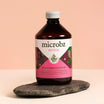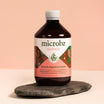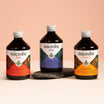Horsetail
Equisetum arvense

Family: Equisetaceae
Which probiotic is it in?: Horsetail is a key herb in Fitness
Habit and cultivation: Native to Europe, found growing in damp, wet regions and sometimes referred to as ‘cosmopolitan weeds’. Recorded as a noxious weed, it spreads quickly, is difficult to irradicate and due to the high silica content in the stems, it destroys the teeth of the stock that eat it.
Actions (known for): Astringent, Anti-haemorrhagic, Diuretic
History of Horsetail
Parts used from the Horsetail
The sterile aerial parts, harvested mid to late summer.
Constituents (bio available chemicals):
Saponin – equisetonin, Alkaloids, Flavonoids, Phytosterols, Silicic acid 5-8% Silicon.
Nutritional constituents:
Indications:
Provides strength and flexibility to the connective tissues of the body including cartilage, tendons, skin, joints, bone, teeth, and blood vessels. Silica is essential in the formation of collagen. It has been used for centuries to support the repair of the body. Also used to strengthen weak nails and hair. Commonly used to assist in urinary tract disorders including chronic cystitis, incontinence and bedwetting. Can be used externally on wounds to stop bleeding and reduce recovery and repair time. Reduces swelling in swollen eyelids.
Dosage:
Dried herb: 3-12 grams daily. Liquid extract (1-2): 20-40ml per week




































